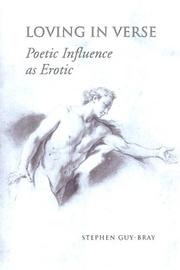| Listing 1 - 1 of 1 |
Sort by
|

ISBN: 1281992127 9786611992125 1442676841 0802092039 0802080456 9781442676848 9780802092038 9781281992123 Year: 2006 Publisher: Toronto, [Ontario] ; Buffalo, [New York] ; London, [England] : University of Toronto Press,
Abstract | Keywords | Export | Availability | Bookmark
 Loading...
Loading...Choose an application
- Reference Manager
- EndNote
- RefWorks (Direct export to RefWorks)
Using concepts from queer theory and close readings of images and allusions in these texts, Loving in Verse demonstrates the importance of homoeroticism to an examination of poetic influence. A discussion of the theories of poetic influence from four twentieth-century writers (T.S. Eliot, Harold Bloom, Roland Barthes, and Frank O'Hara) concludes Guy-Bray's analysis."--Jacket. "Loving in Verse examines how three poets present their relationship to their most important predecessors, beginning with Dante's use of Virgil and Statius in the Divine Comedy, moving on to Spenser's use of medieval English poets in the Faerie Queene, and finally addressing Hart Crane's use of Whitman in The Bridge. In each case, Guy-Bray shows how the younger poet presents himself and the older poet as part of a male couple. He goes on to demonstrate how male couples are, in fact, found throughout these poems, and while some are indeed familial or hostile, many are romantic or sexual.
LITERARY CRITICISM --- Poetry --- Homosexuality in literature --- Literature - General --- Languages & Literatures --- History and criticism --- Homosexuality in literature. --- Poetry. --- Dante Alighieri, --- Spenser, Edmund, --- Crane, Hart, --- History and criticism. --- Criticism --- Poems --- Verses (Poetry) --- Literature --- Philosophy --- Faerie queene (Spenser, Edmund) --- Divina commedia (Dante Alighieri) --- Bridge (Crane, Hart) --- Cumégia (Dante Alighieri) --- Divine comedy (Dante Alighieri) --- Divina comedia (Dante Alighieri) --- Commedia (Dante Alighieri) --- Comedy (Dante Alighieri) --- Poema sacro (Dante Alighieri) --- Comedia (Dante Alighieri) --- Edmund Spenser, The Faerie queene (Spenser, Edmund) --- Faerie queen (Spenser, Edmund) --- Faery queen (Spenser, Edmund)
| Listing 1 - 1 of 1 |
Sort by
|

 Search
Search Feedback
Feedback About UniCat
About UniCat  Help
Help News
News